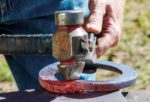Advertise Follow Us
American Farriers Journal

View Archived Issues
September/October 2018
Volume: 44
Edition: 6
American Farriers Journal is the “hands-on” magazine for professional farriers, equine veterinarians and horse care product and service buyers.
-
Table Of Contents
Table Of Contents
Vet Group Withdraws Farrier Exemption Shift
Industry’s reaction prompts AVMA to drop proposed changeRead MoreShoeing For A LivingColorado Farrier Embraces Learning Opportunities to Benefit Horses
Steve Foxworth incorporates a mindset of learning and growth in his life and hoof-care practiceRead MoreWhat Causes Supporting Limb Laminitis?
Improving circulation in loaded foot is the key to avoiding diseaseRead MoreHow to Treat Hoof Abscesses
Farriers and veterinarians often deal with abscesses. Here is some practical advice for understanding and treating theseRead MoreHow is Your Hoof Care Affecting the Inside of the Equine Foot?
Identifying traumatized internal structures can help prevent and intervene on pathologyRead MoreTrimming, Shoeing Backyard Horses Critical To Farrier Success
While trimming and shoeing backyard horses is a great way to get started in the business, this part of the footcare market still represents a large portion of income for many veteran farriersRead MoreThe Importance of Regular Shoeing
Waiting just a few weeks will result in costly long-term health problemsRead MoreHow Reading the Horse Can Make Your Job Easier
Reading a horse’s body language can help you understand what frame of mind it’s in — and give you a guideline for approaching the horse.Read MoreBritish Columbia Farriers Pursuing Regulation
Groups team up to change veterinary supervision lawRead MoreAdvice On A Multi-Farrier Business
Three horseshoers share their insight on managing a multi-farrier practiceRead MoreWhat Does A Barrel Horse Need To Succeed?
Appropriate hoof care will help provide the confidence a barrel horse needsRead MoreSkill And Practicality Meet For Concave Challenge
For this year’s Summit Mail-In Forging Exercise, this concave shoe with clips and stud holes will test you with plenty of elementsRead MoreDon’t Panic When Encountering Milky Frog Fluid
Plugged ducts can result in white discharge during trimmingRead MoreResearch Journal: September/October 2018
The information, ideas and opinions expressed are those of the author and do not necessarily represent those of the United States Department of Agriculture.Read More -
Featured Articles
Featured Articles
Shoeing For A LivingColorado Farrier Embraces Learning Opportunities to Benefit Horses
Steve Foxworth incorporates a mindset of learning and growth in his life and hoof-care practiceRead MoreHow is Your Hoof Care Affecting the Inside of the Equine Foot?
Identifying traumatized internal structures can help prevent and intervene on pathologyRead MoreDon’t Panic When Encountering Milky Frog Fluid
Plugged ducts can result in white discharge during trimmingRead More - Digital Edition
-
Online Extras
Online Extras




















